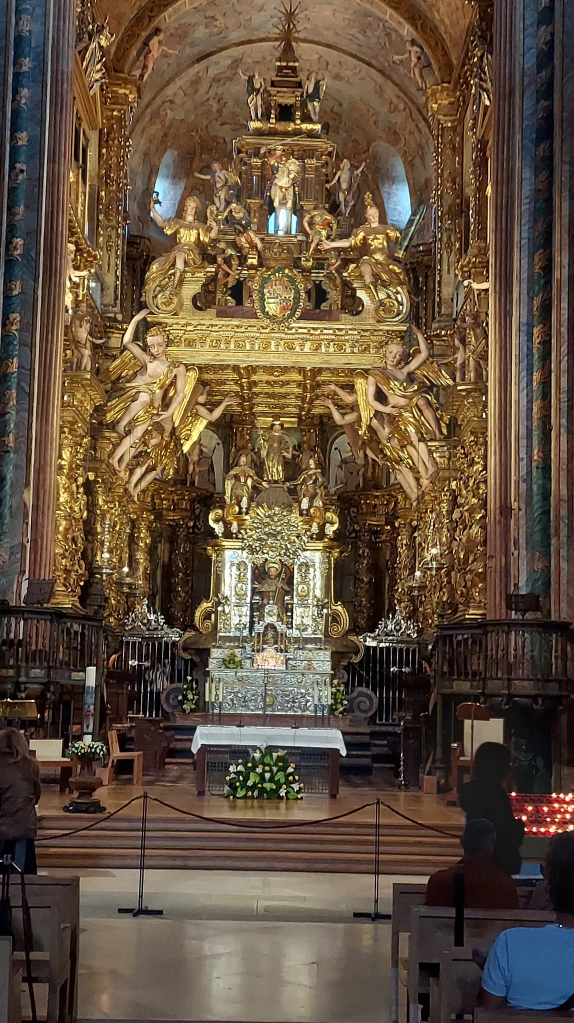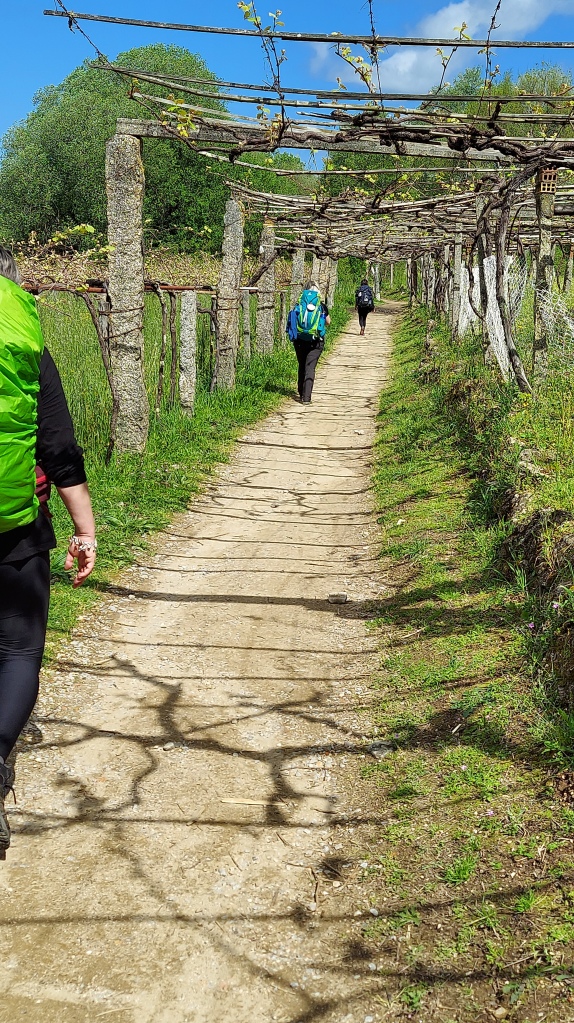This is the fourth and final part in a series. Part 1 | Part 2 | Part 3
Finally, we can sleep in. Santiago wakes slowly, and after breakfast at the Café Las Vegas—finally, true protein instead of a halfhearted menú peregrino—we start a circuit, around the compact downtown but always back to the plaza before the cathedral. Here the ritual repeats itself all day: exhausted pilgrims stride in and collapse, grinning. Some dance and jump and sing, some sit in quiet contemplation. Some embrace fellow travelers, others ask total strangers to take their pictures. Some, proud of their conquest, march off to collect their compostela or take a shower or find the nearest bar. Others linger, perhaps to lean up against the arcade on the university building opposite the cathedral, little live gargoyles lining the wall, there to watch the rite repeat itself.
The crowd who broke up the final day rolls through first. The Czech guy, now beaming and triumphant, takes his sweet time in the square. Ron and Marnie roll in a bit later, and I get a hug from their friend when she hunts them down at the bar, only two beers ahead of her. Of course there are more chance encounters with Alan and the Spaniards, too.
We attend the Pilgrim’s Mass. Alas, the botafumeiro is not on display today, but we do get a service befitting of the Camino. Priests from Korea, Ireland, and the US join the Spaniards who lead it, most words in Spanish but with nods to other languages. The students from Sevilla get a special shoutout, and one comes forward to read some words on what their trek has meant. Maybe half the congregation takes communion, the rest merely there to absorb it. Catholicism in the literal sense of the word.
Lunch comes with mediocre service on a pleasant patio. I then bid my dad Buen Camino as he rolls north to A Coruña, off on the final leg of his six-week journey across Iberia. I broaden my circuit around the city as I kill time before my own bus back south. I chat with Alan and Maria on a placid park bench, and I catch them yet again as I head for the bus station. I flag down Julie and Susan from Saskatchewan on the plaza, and later share a beer with them; they’ve befriended Marcia and Michelle from the States on the Spiritual Variant, though my bus leaves before their scheduled rendezvous, and I do not see them in the flesh.
Instead, I turn a reluctant back on Santiago and begin the return journey. It is a three-and-a-half-hour bus ride back to Porto, much of it lining the very route I just walked, past the factory in Pontecesures, the suspension bridge on the Rías Baixas, past a familiar little market outside Valença. We stop in Vigo, a clump of ugly apartment blocks on a stunning strait, as the sun slips toward the Illas Atlánticas, the last dots of land before the great expanse of ocean beyond. The sparsely filled bus is mostly populated by southbound pilgrims, including two women from Washington State who have just been to Muxia and Fisterra on the coast, and my seatmate, a shy, thoughtful Italian army kid on leave, who heads to Porto to start his own Camino. The cycle starts anew.

The Italian kid and I wander through the station together before we part ways in bewilderment at the signage in Campanhã station. After wandering in a circle I befriend a local who is equally confused, and she and I eventually find our way to the Metro together. The navigation challenges continue when I come up out of the Metro into a pile of construction barriers, as parts of downtown Porto are torn up for the construction of a new Metro line. Nevertheless, I find the Torre dos Clérigos, lit up in purple at night, and pick my way up a hill toward my hostel on the Jardim de Cordoaria, a pleasant leafy square bisected by a cable car. I’ve taken a private room in the hostel, though I spend some time at its bar sipping port and meeting the fellow guests, including a Brit who has just wrapped up several years working on his uncle’s butterfly farm in Kenya. As one does, of course. The room is lovely, with a grand view from a tiny balcony out on the square, though the party at the bars down below rages until past two AM, the revelers singing and shouting ceaselessly. It is a Wednesday.
Porto is to Lisbon what Barcelona is to Madrid: the smaller, cooler second city of an Iberian nation. Of course the port wine caves across the in Vila Nova de Gaia and the vineyards up the Douro may be its foremost claim to fame, but this is a flashy city, draped over hills rising up from the river, great church towers and pastel buildings with gilded balconies. Foremost, however, are the azulejos, the stunning blue tile that brings life to facades and back alleys and the São Bento train station. I don’t have nearly enough time, and it is a hot day to plug up and down its hills on still-battered feet. Still, I catch as much as I can, up and down hills and across the river, relaxing in the shade and dispensing some advice to Denise, the solo Canadian tentatively setting out on her Camino later that day.

Before long I am on the slow train back to Lisbon, which leaves on time but somehow gets two hours behind schedule. I befriend some Argentines, with whom I presage my next adventure. After some initial exasperation I find Zen as we roll through Portuguese villages in the late afternoon sun, and finally the train roles back into Santa Apolónia station in time for a stroll down the waterfront and into a sunset behind the Ponte 25 de Abril, the great red suspension bridge over the mouth of the Tagus. I am hungry, but I am compelled to join the watching crowd beside the Praza de Comercio, cuddling lovers and boisterous families, crews of friends laughing in unison. I am one with the sea.
I stroll back up and down Baixa, enjoy one last leisurely late-night meal, people-watch and admire the skilled buskers. I turn aside the double-digit number of guys who ask if I want marijuana or hash. As the crowds begin to thin and I tire of these circuits, I know it is time. I shuttle to the airport for an all-nighter ahead of a five AM takeoff for Amsterdam. I am headed home, but my Camino, I think, is still in one of its earlier stages.
I say this because it will take time to know what this Camino means. I knew this going in, and I will need to sit with it, even as other adventures build. There was occasional frustration, tired feet and a narrowed scope of life; bad weather days and language barriers drained the mood at times. (While I am fully functional in Spanish and possess more rudimentary Portuguese than most visitors from abroad, I appear to have traded my dad’s faculty for delighting in play with different languages for an obsession with precision in one.) But the Camino brought out long times of intense life in the moment, in striding up sun-splashed country lanes or strolling through teeming plazas, savoring a victory beverage and creating temporary travel friends.

There were also some moments of intense emotion, those flashes captured by Andrew McCarthy in an account of his Camino with his 19-year-old son, Walking with Sam: those moments when “the awful truth of the sweetness of life throbs in an unguarded mix of emotions.” I stood in front of the Cruz dos Mortos in the pouring rain and thought of another backpacking drip in a downpour with a cousin, now departed from this earth. Images of Mary cradling Jesus took me back to age eight; carefree Spanish kids on a plaza tugged at some glimpse of a childhood long since gone. Sunglasses hid swimming eyes as I gazed up at the spires of the cathedral at the end of our trek. I watched my dad disappear up a street in Santiago as he continued on to his next adventure at his ever-steady pace. I have always felt life vividly, but with every other external worry stripped away, the fierce intensity of the moment took a control it can never muster on a random Tuesday at the office.
It is alright to hold these throbs of emotion in contradiction. In Returning from Camino, Alexander John Shaia describes the internal chaos many pilgrims face after their returns from Santiago. “This type of energy is far more powerful than we can imagine, and it is almost impossible for our human intellect to contain it,” he writes. “It is largely beyond our rational control,” and we must “simply be with the energy,” knowing these oscillations will occur.
Perhaps something seismic is afoot and some insight will come, either in a burst of reflection or in accumulated thoughts over time. Perhaps nothing will, and I will simply look back on this trip as a once-in-a-lifetime venture through fun cities with my dad. That alone would be a sweet enough gift. But I have opened myself to every possibility, and that is why we walk these Caminos.




